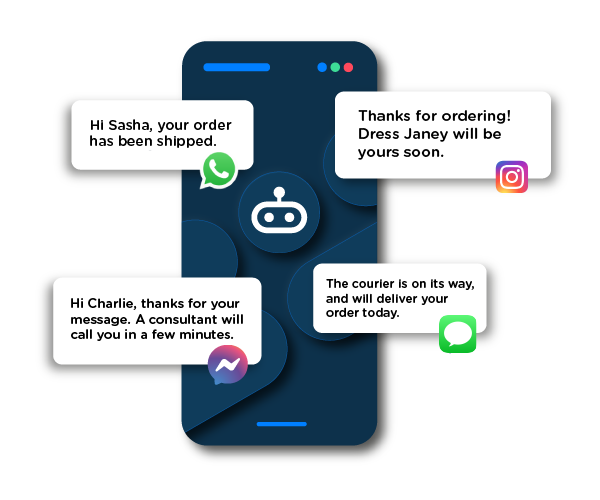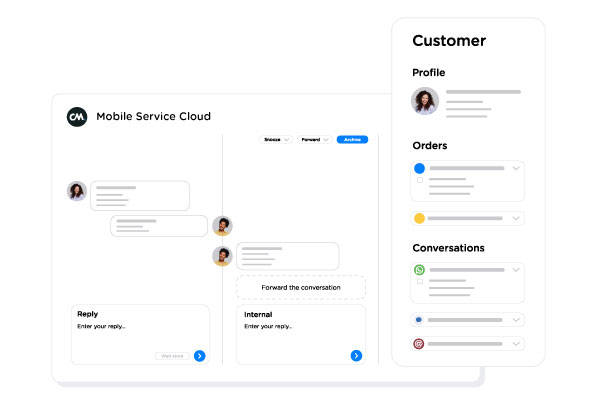- What Are the Top Instant Messaging Apps for Customer Service in Southeast Asia?
- Facebook Messenger
- Viber
- Telegram
- SMS
- Apple Messages for Business
- Pro Tips for Providing Customer Support on Chat App Channels
- 1. Make Your Chat App Channels Accessible
- 2. Automate Chat Responses to Frequently Asked Questions (FAQs)
- 3. Manage Conversations in Various Chat App Channels in One Place
- Unlock New Customer Support Opportunities With Chat Support
Enter the chatbot, which can be your customer service team’s next “new hire.”
Capable of conversing with customers about simple queries 24/7, chatbot programs can provide the speedy, effective customer support responses that customers demand.
It’s no wonder such chatbots are the fastest-growing channel in the Asia-Pacific, with nearly one-third of consumers using chatbots to interact with customer service!
That said, there are plenty of chat app channels that you can build chatbots for on your communications platform. If you’re operating in Southeast Asia, you’ll want to prioritize offering support on the channels that customers in this region use.
Don’t expect customers to sign up for a chat app channel just to contact your business, because they might not be willing to make the effort. Depending on the situation, they might find it easier to leave you a bad online review—which is something you definitely don’t want.
In this article, we’ll explore the top chat app channels in Southeast Asia, plus what makes them worth providing customer support on. We’ll also share tips for improving the service experience on these channels so you keep customer goodwill in your business high, providing them with great customer service.
What Are the Top Instant Messaging Apps for Customer Service in Southeast Asia?
Check out the apps you’ve downloaded on your phone. Which instant messaging apps do you have on there? WhatsApp? And possibly Facebook Messenger too?
You may not realize it, but you’re probably already using some of Southeast Asia’s top instant messaging apps to connect with loved ones and brands. Different chat apps enjoy differing levels of popularity in Southeast Asia, so let’s take a look at some of these apps in closer detail:
Owned by Meta, WhatsApp is a highly popular chat app channel in Southeast Asia. Businesses in the region have tapped on WhatsApp Business to accept customer orders, provide quick services, offer customer support, and more.
Facebook Messenger
Facebook Messenger provides an avenue for Facebook users to chat with other Facebook users—including brands—even if they don’t have the recipient’s phone number. As of April 2022, Indonesia has at least 28.7 million active Facebook Messenger users, while this figure rises to at least 55.7 million for users of this messaging app in Vietnam.

Viber
Maintained by Rakuten, Viber enjoys an especially active user base in the Philippines. There, the service clocked an estimated 9.1 million active users from January to April 2022 (for Android devices alone!) The main Viber service is free, while users can also pay to make international calls through the app.
Telegram
Besides letting users send animated stickers and access chats across multiple devices, Telegram also sports a popular Channels feature. By setting up their own Telegram Channel, businesses such as Klook SG have cultivated a captive audience of Telegram users for pushing mass updates and promotions in Singapore.
SMS
SMS may seem old-fashioned, but it still enjoys a good amount of usage. And no, we aren’t referring to just the sending of one-time SMS passwords.
Using an SMS API integration to scale their communications, businesses may also use SMS to send customers delivery alerts, appointment reminders, and other brief messages in real time.
SMS open rates can be as high as 98%, so this is one chat channel not to be underestimated.
Apple Messages for Business
Businesses can use Apple Messages for Business to communicate with iOS device users in various ways, such as scheduling appointments and providing customer support. However, this channel has limited effectiveness in helping businesses service non-iOS users.
Pro Tips for Providing Customer Support on Chat App Channels
You’ve picked the chat app channels you’d like to add to your customer service processes. How can customer support agents make the most of them? Here are three pro tips that you can do to ensure good customer support:
1. Make Your Chat App Channels Accessible
Publicize your chat app channels once you’ve set them up! Your customers need to know these channels exist before they can use them.
Making your chat app channels accessible can be as straightforward as linking to them on your website. You can also add these links to your social media pages.
But ensure the links are clickable, too, because having to manually type links—especially long ones—can be a major deterrent for customers.
An alternative to links would be QR codes, where customers can scan these codes with their phone to launch your chat app channel. QR codes are especially useful if customers are interacting with your business offline, such as at your brick-and-mortar store, where link-clicking isn’t so convenient.
2. Automate Chat Responses to Frequently Asked Questions (FAQs)
As you attend to support queries from customers on live chat, you may notice customers asking certain questions again and again. For example, logistics businesses may regularly get questions on customers’ order statuses. Alternatively, e-commerce businesses may receive refund requests from customers.
By adding a simple scripted FAQ chatbot to your support page, you’ll be able to automate instant replies to straightforward questions 24/7. Learn more about the FAQ chatbot here. You can also tap on an artificial intelligence (AI) chatbot solution such as Conversational AI Cloud for next-level chatbot service. Compared to their scripted cousin, AI chatbots can better understand the context behind customers’ questions to enhance the appropriateness of their responses.
Whether you opt for a scripted or AI chatbot, the result is that customers can obtain help quicker. You also free up manpower to address more complex queries that your chatbot refers to your customer service team.
3. Manage Conversations in Various Chat App Channels in One Place
As you strive to provide support on as many chat app channels as possible, it can be a chore for your customer service team to log into different channels and navigate their respective interfaces. A customer service platform like Mobile Service Cloud eliminates such hassle by integrating chats from various chat app channels into one omnichannel Agent Inbox.
To help your team get greater context on queries, the customer service platform may also integrate with your customer data platform to display your customers’ profiles next to support conversations.
For example, Mobile Service Cloud integrates with our Mobile Marketing Cloud customer engagement solution to enrich support conversations with context on customers’ order histories and promotional campaigns received.
Chatting with customers thus becomes effortless for your customer service team, who can deliver more personalized responses while exploring opportunities to boost sales. Meanwhile, customers receive support from their preferred chat app, enhancing customer satisfaction. It’s a win-win situation!
Unlock New Customer Support Opportunities With Chat Support
Offering support on chat app channels is an investment that can significantly pay off if undertaken with the right strategy. For a business in Southeast Asia, this involves establishing a support presence on the most popular chat app channels in the region.
But as maintaining a presence on more channels can lead to greater operational complexity, businesses should also take steps to streamline their support operations.
CM.com’s Mobile Service Cloud provides the essential chatbot and multi-channel conversational commerce infrastructure for integrating Southeast Asia’s top chat app channels in one place.

Facilitating collaborative communication among your customer service team, Mobile Service Cloud allows the smooth and efficient management of support conversations across multiple channels and the delivery of outstanding customer service. It also empowers customers to communicate with your business via the channels of their choice and get the assistance they seek.
The result is satisfied customers who may become loyal advocates for your brand, helping you raise brand awareness and attract new customers. You even stand to reap more sales from new and repeat customers alike!
Explore Mobile Service Cloud to learn how it can help your business provide a seamless support experience on your customers’ preferred channels anytime and anywhere.
